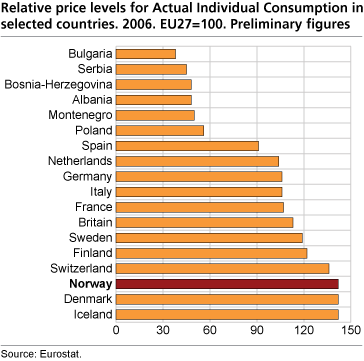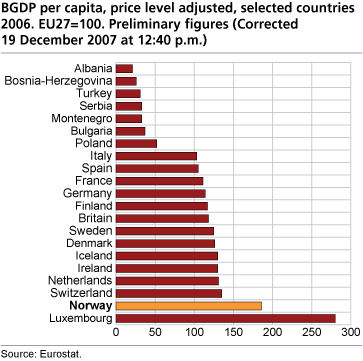Content
Published:
This is an archived release.
Small changes in price levels and GDP
The price level differences between European countries in the period 2004 to 2006 were minor. Iceland, Denmark, Norway and Switzerland were the most expensive countries in Europe in 2006.
In 2006, the price level of goods and services for actual individual consumption (the sum of household consumption expenditures and individual consumption in general government and non-profit organisations serving households) was 42 per cent above the EU average in Norway, Iceland and Denmark. This is around 13 per cent higher than the level in Ireland, 17 per cent over Finland's level and 19 per cent higher than Sweden’s. Amongst the four largest EU economies, Britain has the highest price level for actual individual consumption, around 13 per cent over the European average. France, Germany and Italy were slightly behind and around 5 per cent above the average. The price levels in the “new” EU member states are still considerably lower than in the EU15, with the exception of Cyprus. In the period 2004-2006, there was a certain move towards a more homogenous European price level.
These results are taken from the European Purchasing Power Parity Survey for the years 2004-2006, which was recently published by Eurostat. 37 European countries participated in the survey. Albania, Montenegro, Serbia and Bosnia-Herzegovina were included from 2005.
GDP 2004-2006: Small changes, growth in Estonia and Latvia
If we compare material living standards in different countries using price level adjusted GDP per capita, there has been generally small changes in the period 2004-2006. The exceptions are Estonia, Latvia and Lithuania, Romania and Slovakia, which have had a marked economic growth in relative terms in the period. In the same period, Norway and Luxembourg had a marked relative growth in price level adjusted GDP.
Only Luxembourg ahead of Norway
In 2006, Norway’s price level adjusted GDP per capita was the second highest in Europe. Only Luxembourg was ahead of Norway while there was a big leap down to other high income countries such as Ireland, Switzerland, Netherlands and Iceland. Norway’s figure was 86 per cent above the EU average and almost 50 per cent above Denmark and Sweden. The differences within the EU are still considerable. The price level adjusted GDP per capita in several of EU countries in Eastern Europe, for instance Estonia, Hungary and Slovakia, was around 50 per cent of that of Ireland, the Netherlands, Austria and Denmark in 2006.
Low price level and GDP in the Balkans
Albania, Bosnia-Herzegovina, Serbia and Montenegro joined the survey for the first time in 2005. The four Balkan states had the lowest price level adjusted GDP per capita. While Serbia and Montenegro were close to the level of the two most recent EU members Romania and Bulgaria, Albania was at the bottom of the table with a price level adjusted GDP per capita that was one fifth of the EU average. The price levels of these four countries are also low. In 2006, the price level for actual individual consumption in Albania, Bosnia-Herzegovina, Serbia and Montenegro was below half of the average EU level. The level is also around 5 to 10 per cent lower than in most eastern member countries like Estonia, Latvia, Lithuania, Czech Republic, Hungary and Poland. In the survey, only the former Yugoslav Republic of Macedonia and Bulgaria have an even lower comparable price level.
See Eurostat's press release og and Analyses .
Norwegian purchasing power in a global contextOn the 17 December 2007, the results from a global purchasing power survey carried out in 2005 were published. The results rely on national accounts figures as well as price level surveys. The survey comprised 147 countries in Africa, Asia, the Middle-East, South America and CIS countries, in addition to countries in the OECD/Eurostat area. The OECD figures include the USA, Canada, Japan, Australia and Mexico. Norway is participating in this international survey via the work led by Eurostat. The global survey work is managed by a coordinating unit in the World Bank, Washington. For more information about global results from World Bank. |
Tables:
- Table 1 Relative price levels for GDP and Actual Individual Consumption. Price level adjusted GDP per capita. 2004. EU27=100
- Table 2 Relative price levels for GDP and Actual Individual Consumption. Price level adjusted GDP per capita. 2005. EU27=100
- Table 3 Relative price levels for GDP and Actual Individual Consumption. Price level adjusted GDP per capita. 2006. EU27=100
This page has been discontinued, see Comparison of price levels in Europe, Annually.
Additional information
Contact
-
Birte Larsen Sandstå
E-mail: birte.sandsta@ssb.no
tel.: (+47) 92 60 56 03
-
Hamdi A. Mohamed
E-mail: hamdi.mohamed@ssb.no
tel.: (+47) 46 81 54 76
-
Norway-ppp@ssb.no
E-mail: norway-ppp@ssb.no


